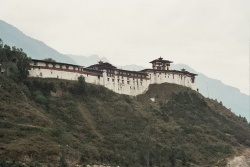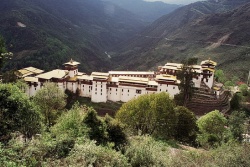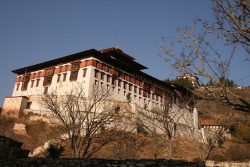Difference between revisions of "Dzong"
(Created page with "<poem> Dzong (from Tibetan རྫོང་, Wylie rDzong, sometimes written Jong) is a distinctive type of fortress architecture found in the present and former Buddhist kin...") |
|||
| (8 intermediate revisions by 4 users not shown) | |||
| Line 1: | Line 1: | ||
| + | [[File:Phodrang Dzong.jpg|thumb|250px|]] | ||
<poem> | <poem> | ||
| − | Dzong (from Tibetan རྫོང་, Wylie rDzong, sometimes written Jong) is a distinctive type of fortress architecture found in the present and former Buddhist kingdoms of the Himalayas: Bhutan and Tibet. The architecture is massive in style with towering exterior walls surrounding a complex of courtyards, temples, administrative offices, and | + | [[Dzong]] (from [[Tibetan]] {{BigTibetan|རྫོང་}}, Wylie rDzong, sometimes written Jong) is a {{Wiki|distinctive}} type of fortress architecture found in the present and former [[Buddhist]] kingdoms of the [[Himalayas]]: [[Bhutan]] and [[Tibet]]. The architecture is massive in style with towering exterior walls surrounding a complex of courtyards, [[temples]], administrative offices, and [[Monks]]' accommodation. |
Characteristics | Characteristics | ||
| − | Distinctive features include: | + | {{Wiki|Distinctive}} {{Wiki|features}} include: |
| − | High inward sloping walls of brick and stone painted white with few or no windows in the lower sections of the wall | + | High inward sloping walls of brick and stone painted white with few or no windows in the lower [[sections]] of the wall |
| − | Use of a surrounding red ochre stripe near the top of the walls, sometimes punctuated by large gold circles. | + | Use of a surrounding red ochre stripe near the top of the walls, sometimes punctuated by large {{Wiki|gold}} circles. |
| − | Use of Chinese-style flared roofs atop interior temples. | + | Use of Chinese-style flared roofs atop interior [[temples]]. |
Massive entry doors made of wood and iron | Massive entry doors made of wood and iron | ||
| − | Interior courtyards and temples brightly colored in Buddhist-themed | + | Interior courtyards and [[temples]] brightly colored in [[Buddhist]]-themed [[Art]] motifs such as the [[Ashtamangala]] or [[Swastika]], for example. |
Regional differences | Regional differences | ||
| − | Bhutan | + | [[Bhutan]] |
| − | Dzongs serve as the religious, military, administrative, and social centers of their district. They are often the site of an annual tsechu or religious festival. | + | [[Dzongs]] serve as the [[religious]], military, administrative, and {{Wiki|social}} centers of their district. They are often the site of an annual tsechu or [[religious]] {{Wiki|festival}}. |
| − | The rooms inside the dzong are typically allocated half to administrative function (such as the office of the penlop or governor), and half to religious function, primarily the temple and housing for | + | The rooms inside the [[dzong]] are typically allocated half to administrative [[function]] (such as the office of the penlop or governor), and half to [[religious]] [[function]], primarily the [[temple]] and housing for [[Monks]]. This division between administrative and [[religious]] functions reflects the idealized [[duality]] of [[Power]] between the [[religious]] and administrative branches of government. |
| − | Tibet | + | [[Tibet]] |
| − | Further | + | Further [[Information]]: Administrative divisions of [[Tibet]] |
| − | The territory of Tibet used to be divided into 53 prefecture districts also called Dzongs. There were two Dzongpöns for every Dzong - a | + | The territory of [[Tibet]] used to be divided into 53 prefecture districts also called [[Dzongs]]. There were two Dzongpöns for every [[Dzong]] - a [[Lama]] (Tse-dung) and a [[layman]]. They were entrusted with both civil and military [[powers]] and are {{Wiki|equal}} in all respects, though subordinate to the generals and the {{Wiki|Chinese}} Amban in military matters,[2] until the ambans' expulsion following the fall of the {{Wiki|Qing Dynasty}} in 1912.[1] Today, 71 counties [[In Tibet]] Autonomous Region are rendered as "[[Dzongs]]" in the [[Tibetan]] [[Language]]. |
| − | Bhutanese | + | {{Wiki|Bhutanese}} [[Dzong architecture]] reached its [[Zenith]] in the 17th century under the [[Leadership]] of the great [[Lama]] [[Shabdrung Ngawang Namgyal]]. The [[Shabdrung]] relied on visions and {{Wiki|omens}} to site each of the [[dzongs]]. {{Wiki|Modern}} military strategists would observe that the [[dzongs]] are well-sited with regard to their [[function]] as defensive fortresses. Wangdue Phodrang [[dzong]], for instance, is set upon a spur overlooking the confluence of the Puna Chhu and Tang Chhu [[Rivers]] thus blocking any attacks by southern invaders who attempted to use a [[River]] route to bypass the trackless slopes of the middle [[Himalayas]] in attacking {{Wiki|central}} [[Bhutan]]. Drukgyel [[dzong]] at the {{Wiki|head}} of [[Paro]] valley guards the [[traditional]] [[Tibetan]] invasion [[Path]] over the passes of the high [[Himalayas]]. |
| − | + | [[File:TrongsaDzong.jpg|thumb|250px|]] | |
| − | Dzongs were frequently built on a hilltop or mountain spur. If the dzong is built on the side of a valley wall, a smaller dzong or watchtower is typically built directly uphill from the main dzong with the purpose of keeping the slope clear of attackers who might otherwise shoot downward into the courtyard of the main dzong below (see image at head of article). Pungtang Dechen Photrang Dzonga at Punakha is distinctive in that it is sited on a relatively flat spit of land at the confluence of the Mo Chhu and Pho Chhu | + | [[Dzongs]] were frequently built on a hilltop or mountain spur. If the [[dzong]] is built on the side of a valley wall, a smaller [[dzong]] or watchtower is typically built directly uphill from the main [[dzong]] with the [[purpose]] of keeping the slope clear of attackers who might otherwise shoot downward into the courtyard of the main [[dzong]] below (see {{Wiki|image}} at {{Wiki|head}} of article). Pungtang Dechen Photrang Dzonga at Punakha is {{Wiki|distinctive}} in that it is sited on a relatively flat spit of land at the confluence of the Mo Chhu and Pho Chhu [[Rivers]]. The [[Rivers]] surround the [[dzong]] on three sides, providing protection from attack. This siting proved {{Wiki|inauspicious}}, however, when in 1994 a glacial lake 90 kilometers upstream burst through its ice dam to [[cause]] a massive flood on the Pho Chhu, damaging the [[dzong]] and taking 23 [[lives]]. |
Construction | Construction | ||
| − | By tradition, dzongs are constructed without the use of architectural plans. Instead construction proceeds under the | + | By [[tradition]], [[dzongs]] are [[constructed]] without the use of architectural plans. Instead construction proceeds under the [[Direction]] of a high [[Lama]] who establishes each [[dimension]] by means of [[Spiritual]] inspiration. |
| − | |||
| − | |||
| − | + | In previous Times the [[dzongs]] were built using corvée labor which was applied as a tax against each household in the district. Under this obligation each family was to provide or hire a decreed number of workers to work for several months at a [[Time]] (during quiet periods in the agricultural year) in the construction of the [[dzong]]. | |
| − | The | + | [[Dzongs]] comprise heavy masonry curtain walls surrounding one or more courtyards. The main functional spaces are usually arranged in two separate areas: the administrative offices; and the [[religious]] functions - including [[temples]] and [[Monks]]' accommodation. This accommodation is arranged along the inside of the outer walls and often as a separate stone tower located centrally within the courtyard, housing the main [[temple]], that can be used as an inner defensible citadel. The main {{Wiki|internal}} structures are again built with stone (or as in domestic architecture by rammed clay blocks), and whitewashed inside and out, with a broad red ochre band at the top on the outside. The larger spaces such as the [[temple]] have massive {{Wiki|internal}} timber columns and beams to create galleries around an open {{Wiki|central}} full height area. Smaller structures are of elaborately carved and painted timber construction. |
| − | The | + | The roofs are massively [[constructed]] in hardwood and {{Wiki|bamboo}}, highly decorated at the eaves, and are [[constructed]] [[traditionally]] without the use of nails. They are open at the eaves to provide a ventilated storage area. They were [[traditionally]] finished with timber [[shingles]] weighted down with stones; but in almost all cases this has now been replaced with corrugated iron roofing. The roof of Tongsa [[dzong]], illustrated, is one of the few shingle roofs to survive and was {{Wiki|being}} restored in 2006/7. |
| − | Modern architecture in the dzong style | + | The courtyards, usually stone-flagged, are generally at a [[higher]] level than the outside and approached by massive staircases and narrow defensible entrances with large wooden doors. All doors have thresholds to discourage the entrance of [[Spirits]]. [[Temples]] are usually set at a level above the courtyard with further staircases up to them. |
| + | [[File:Zong_at_paro.jpg|thumb|250px|]] | ||
| + | {{Wiki|Modern}} architecture in the [[dzong]] style | ||
| − | Larger modern buildings in Bhutan often use the | + | Larger {{Wiki|modern}} buildings in [[Bhutan]] often use the [[Form]] and many of the {{Wiki|external}} characteristics of [[Dzong architecture]] in their construction, although incorporating {{Wiki|modern}} techniques such as a concrete frame. |
| − | The campus architecture of the University of Texas at El Paso or UTEP is a rare example of dzong style seen outside the Himalayas. Initial phases were designed by El Paso architect Henry Trost, and later phases have continued in the same style. | + | The campus architecture of the {{Wiki|University}} of Texas at El Paso or UTEP is a rare example of [[dzong]] style seen outside the [[Himalayas]]. Initial phases were designed by El Paso {{Wiki|architect}} Henry Trost, and later phases have continued in the same style. |
| − | Recent scholarship | + | Recent {{Wiki|scholarship}} |
| − | Recent research by the prominent Bhutanese scholar C.T. Dorji suggests that the original 'model dzong' may not be Simtokha Dzong as commonly believed, but Dobji Dzong, built in 1531 at an altitude of 6600 feet on a cliff facing the gorge of the Wong Chhu. Unlike the dzongs built under the | + | Recent research by the prominent {{Wiki|Bhutanese}} [[scholar]] C.T. Dorji suggests that the original 'model [[dzong]]' may not be Simtokha [[Dzong]] as commonly believed, but Dobji [[Dzong]], built in 1531 at an altitude of 6600 feet on a cliff facing the gorge of the Wong Chhu. Unlike the [[dzongs]] built under the [[Direction]] of the [[Shabdrung]] for defensive purposes, Dobji [[Dzong]] was [[constructed]] to serve a [[religious]] [[purpose]], marking the spot where Ngawang Chogyel "...followed a spring [[water]] which originated from beneath the [[throne]] of [[Jetsun Milarepa]] in [[Druk]] Ralung to find a suitable site for establishing a center to propagate [[Drukpa]] [[Kagyu]] teachings in [[Bhutan]]". |
</poem> | </poem> | ||
{{R}} | {{R}} | ||
[http://en.wikipedia.org/wiki/Dzong en.wikipedia.org] | [http://en.wikipedia.org/wiki/Dzong en.wikipedia.org] | ||
[[Category:Buddhist Terms]] | [[Category:Buddhist Terms]] | ||
| + | [[Category:Dzong]] | ||
| + | [[Category:Bhutan]] | ||
Latest revision as of 11:34, 14 December 2013
Dzong (from Tibetan རྫོང་, Wylie rDzong, sometimes written Jong) is a distinctive type of fortress architecture found in the present and former Buddhist kingdoms of the Himalayas: Bhutan and Tibet. The architecture is massive in style with towering exterior walls surrounding a complex of courtyards, temples, administrative offices, and Monks' accommodation.
Characteristics
Distinctive features include:
High inward sloping walls of brick and stone painted white with few or no windows in the lower sections of the wall
Use of a surrounding red ochre stripe near the top of the walls, sometimes punctuated by large gold circles.
Use of Chinese-style flared roofs atop interior temples.
Massive entry doors made of wood and iron
Interior courtyards and temples brightly colored in Buddhist-themed Art motifs such as the Ashtamangala or Swastika, for example.
Regional differences
Bhutan
Dzongs serve as the religious, military, administrative, and social centers of their district. They are often the site of an annual tsechu or religious festival.
The rooms inside the dzong are typically allocated half to administrative function (such as the office of the penlop or governor), and half to religious function, primarily the temple and housing for Monks. This division between administrative and religious functions reflects the idealized duality of Power between the religious and administrative branches of government.
Tibet
Further Information: Administrative divisions of Tibet
The territory of Tibet used to be divided into 53 prefecture districts also called Dzongs. There were two Dzongpöns for every Dzong - a Lama (Tse-dung) and a layman. They were entrusted with both civil and military powers and are equal in all respects, though subordinate to the generals and the Chinese Amban in military matters,[2] until the ambans' expulsion following the fall of the Qing Dynasty in 1912.[1] Today, 71 counties In Tibet Autonomous Region are rendered as "Dzongs" in the Tibetan Language.
Bhutanese Dzong architecture reached its Zenith in the 17th century under the Leadership of the great Lama Shabdrung Ngawang Namgyal. The Shabdrung relied on visions and omens to site each of the dzongs. Modern military strategists would observe that the dzongs are well-sited with regard to their function as defensive fortresses. Wangdue Phodrang dzong, for instance, is set upon a spur overlooking the confluence of the Puna Chhu and Tang Chhu Rivers thus blocking any attacks by southern invaders who attempted to use a River route to bypass the trackless slopes of the middle Himalayas in attacking central Bhutan. Drukgyel dzong at the head of Paro valley guards the traditional Tibetan invasion Path over the passes of the high Himalayas.
Dzongs were frequently built on a hilltop or mountain spur. If the dzong is built on the side of a valley wall, a smaller dzong or watchtower is typically built directly uphill from the main dzong with the purpose of keeping the slope clear of attackers who might otherwise shoot downward into the courtyard of the main dzong below (see image at head of article). Pungtang Dechen Photrang Dzonga at Punakha is distinctive in that it is sited on a relatively flat spit of land at the confluence of the Mo Chhu and Pho Chhu Rivers. The Rivers surround the dzong on three sides, providing protection from attack. This siting proved inauspicious, however, when in 1994 a glacial lake 90 kilometers upstream burst through its ice dam to cause a massive flood on the Pho Chhu, damaging the dzong and taking 23 lives.
Construction
By tradition, dzongs are constructed without the use of architectural plans. Instead construction proceeds under the Direction of a high Lama who establishes each dimension by means of Spiritual inspiration.
In previous Times the dzongs were built using corvée labor which was applied as a tax against each household in the district. Under this obligation each family was to provide or hire a decreed number of workers to work for several months at a Time (during quiet periods in the agricultural year) in the construction of the dzong.
Dzongs comprise heavy masonry curtain walls surrounding one or more courtyards. The main functional spaces are usually arranged in two separate areas: the administrative offices; and the religious functions - including temples and Monks' accommodation. This accommodation is arranged along the inside of the outer walls and often as a separate stone tower located centrally within the courtyard, housing the main temple, that can be used as an inner defensible citadel. The main internal structures are again built with stone (or as in domestic architecture by rammed clay blocks), and whitewashed inside and out, with a broad red ochre band at the top on the outside. The larger spaces such as the temple have massive internal timber columns and beams to create galleries around an open central full height area. Smaller structures are of elaborately carved and painted timber construction.
The roofs are massively constructed in hardwood and bamboo, highly decorated at the eaves, and are constructed traditionally without the use of nails. They are open at the eaves to provide a ventilated storage area. They were traditionally finished with timber shingles weighted down with stones; but in almost all cases this has now been replaced with corrugated iron roofing. The roof of Tongsa dzong, illustrated, is one of the few shingle roofs to survive and was being restored in 2006/7.
The courtyards, usually stone-flagged, are generally at a higher level than the outside and approached by massive staircases and narrow defensible entrances with large wooden doors. All doors have thresholds to discourage the entrance of Spirits. Temples are usually set at a level above the courtyard with further staircases up to them.
Modern architecture in the dzong style
Larger modern buildings in Bhutan often use the Form and many of the external characteristics of Dzong architecture in their construction, although incorporating modern techniques such as a concrete frame.
The campus architecture of the University of Texas at El Paso or UTEP is a rare example of dzong style seen outside the Himalayas. Initial phases were designed by El Paso architect Henry Trost, and later phases have continued in the same style.
Recent scholarship
Recent research by the prominent Bhutanese scholar C.T. Dorji suggests that the original 'model dzong' may not be Simtokha Dzong as commonly believed, but Dobji Dzong, built in 1531 at an altitude of 6600 feet on a cliff facing the gorge of the Wong Chhu. Unlike the dzongs built under the Direction of the Shabdrung for defensive purposes, Dobji Dzong was constructed to serve a religious purpose, marking the spot where Ngawang Chogyel "...followed a spring water which originated from beneath the throne of Jetsun Milarepa in Druk Ralung to find a suitable site for establishing a center to propagate Drukpa Kagyu teachings in Bhutan".


